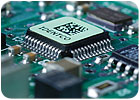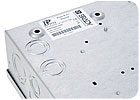Advances in materials, inks and adhesives are expanding the applications for labels on parts and assemblies.

There are many high-tech ways to mark identification codes and text directly onto parts. These include lasers, dot-peening and ink-jet printing. Sometimes, however, the good old self-adhesive label is still the most cost-efficient way to go. Moreover, thanks to new materials, laminates, inks and adhesives, labels are viable for more applications than ever before.
“There’s absolutely still a role for labels,” says Nicole Nelson, marketing manager for new products at Brady Worldwide (Milwaukee). “The surface of a part isn’t always going to be receptive [to direct part marking], or you may not want the mark to be as permanent as an etched mark. You may want the information to change.”
The technology for direct part marking-particularly lasers-is also expensive. “In almost every case, labeling is less expensive than direct part marking,” says Bruce R. Wray, marketing manager for Computype Inc. (St. Paul, MN).
Engineers who think labels couldn’t withstand their particular application should reconsider the technology, advises Ryan Lucas, marketing and applications manager for Identco International Corp. (Ingleside, IL). “A lot of people think labels are just paper,” he says. “But, labels can also be printed on vinyl, polyester, polyimide and other materials that can withstand heat, cold, moisture and chemicals.”
For example, Identco’s TT403 miniature labels are for printed circuit boards and electronic components. Made from polyester or polyimide, the labels can withstand the harsh thermal profiles and aggressive fluxes and cleaners associated with lead-free electronics assembly. As small as 3 millimeters square, the labels can be printed with text, bar codes or Data Matrix codes, either by Identco or on-demand on the assembly line. The labels are supplied on reels molded from static-dissipative, recyclable plastic.
Preprinted labels can be applied by standard pick-and-place equipment using a feeder from Hover-Davis Inc. (Rochester, NY). Blank labels can be printed and applied with the Ævo automatic labeling machine from Accuplace (Plantation, FL) or the DataPlace LCL from Amistar Automation Inc. (San Marcos, CA).
If assemblers want to track more information that can be tied to 1D or 2D codes, a flat, passive radio frequency identification (RFID) tag can be sandwiched between the face stock of the label and its adhesive. Labels with embedded RFID tags are larger and more expensive than ordinary labels ($0.25 per label vs. $0.02 per label), but they also convey much more information. The process of encoding and verifying the tag takes more time than simply printing a label, but that time is made up later by eliminating the need to manually scan bar codes at assembly stations down the line.
Labels can do more than just display a bar code or serial number. Labels can warn consumers of operating hazards or inform them about maintenance procedures. Labels can show that a product meets environmental, industry or consumer standards, such as UL certification or lead-free assembly. And, labels can provide branding information, like the ubiquitous “Intel Inside” sticker attached to computers.
One of the fastest growing applications for labels is to help assemblers certify the integrity of their products and deal with warranty claims. For example, labels can indicate whether a consumer has misused or abused an assembly. When one such label is removed, it leaves the word “void” in a sticky, permanent residue on the part’s surface. Other labels are designed so they’re impossible to remove in one piece. Another type of label turns color if the assembly is overheated or submerged in water.
Counterfeit products are a real concern for OEMs today. Watches, auto parts and even pacemakers are among the many assemblies that have been counterfeited in recent years. Labels can help assemblers prevent such fraud, says Lucas. For example, labels can be printed with a special ink that is invisible in ordinary light but fluoresces under ultraviolet light. Alternatively, anticounterfeit labels can have microprinting or even microtaggants-tiny color-coded particles that can only be detected by microscope, laser light, electromagnetic sensors or handheld X-ray fluorescence spectrometry. Counterfeiters might be able to copy logos and text, but they couldn’t duplicate such hidden information.

Specifying Labels
When choosing labels and labeling equipment, engineers should begin with the assembly itself. Beyond the usual factors of production volume and variety, engineers should think about the information the label will display; the surface to which the label will be applied; the amount of space available for the label; the chemicals, forces and environmental conditions to which the label will be exposed; and the length of time the label is expected to last. Engineers should also consider if color is necessary on the label or if their labeling requirements will change in the future.“A lot of times, people think of the label last,” says Nelson. “They’ll pick any label only to discover later that it won’t adhere to a particular powder coating.”
An often overlooked consideration is whether the assembly will need to meet certain consumer or industry standards, says Wray. For example, Underwriters Laboratories has strict standards for the performance of product safety labels, as well as for how its mark should appear on certification labels.
Next, engineers must decide whether to use preprinted labels or print the labels on the line. Printing in-house allows assemblers to print labels in small quantities, to vary the information printed on the label, and to change label materials and specifications as needed. On the downside, assemblers will need to invest in hardware, software and training. Printing and verifying the information on the label also adds time to the assembly process. Buying preprinted labels requires no capital investment, and the quality of the labels is guaranteed. On the other hand, preprinted labels may have a limited shelf life, and if labeling requirements change, assemblers may be stuck with unusable inventory.
“If you print on-demand, you can print one label or 1,000,” Nelson points out. “If you buy them, there’s typically a minimum quantity.”
For printing the label, engineers have two options: thermal transfer printing or direct thermal printing. In thermal transfer printing, a linear printhead heats a resin or wax ribbon to transfer markings to the label material. In direct thermal printing, the printhead heats the label material itself to make the markings. Because of the cost of the ribbon, thermal transfer printing is more expensive than direct thermal printing. However, thermal transfer printing is faster and more durable than direct thermal printing.
“The problem with direct thermal printing is that the label can’t take heat,” says Nelson. “If the label is stuck in a truck in Phoenix in the middle of summer, the whole thing will turn black.”
Machine Automatically Labels Wire, Cable
Wiring up control cabinets and other complex electrical assemblies would be impossible without some way to identify individual wires and cables. As with other product identification applications, assemblers can choose from an assortment of technologies to get the job done. More often than not, however, the self-adhesive label is still the best option.Now, the task of printing and applying labels on wire and cable just got easier with the introduction of the SwiftMark from HellermannTyton (Milwaukee). The machine automatically prints and applies a self-laminating label to a wire in just over 4 seconds. The SwiftMark can be operated as a stand-alone semiautomatic machine, or it can be integrated into a fully automatic cutting, stripping and crimping system from Komax Corp. (Buffalo Grove, IL).
“An operation that once took 15 to 30 seconds now takes less than 5 seconds,” says Todd Fries, marketing manager for quality and identification products at HellermannTyton. “A process that was once done by one or more operators on the back end of the operation can now be brought on-line, which save manufacturers $50,000 to $100,000 per year.”
The label is a band of white vinyl with a clear tail. The vinyl resists chemicals and solvents, and the clear tail overwraps the white section to protect the printed information. The printable area ranges in size from 0.5 inch by 0.5 inch to 2 inches by 1.5 inches. The labels are printed by a thermal transfer printer at a resolution of 300 dots per inch.
“You can print anything on the label,” says Fries. “Usually, it’s just a two- to three-digit code that tells an assembler where to plug the wire.”
The machine can wrap wires ranging from 0.06 to 0.75 inch in diameter. Terminals or connectors can be attached to the wire prior to labeling, and labels can be placed as close to 0.5 inch from the end of the wire. The machine is equipped with USB, parallel port and serial connections, and label files can be stored on a removable SD card.
Compared with other methods of marking wires, labeling has its niche. In hot stamping, a heated type wheel melts alphanumeric text into the insulation. Alternatively, a laser can be used to mark wire insulation treated with light-sensitive pigments. Or, an ink-jet printer can apply codes or text with a fine stream of ink.
“Some insulation materials won’t accept ink, and you can’t print on braided wires,” says Fries. “Hot stamping actually melts or burns the insulation, and a lot of manufacturers don’t want that. Besides, a label is just easier to read.”
For more information on the SwiftMark, call 800-822-4352 or visitwww.hellermanntyton.com.
